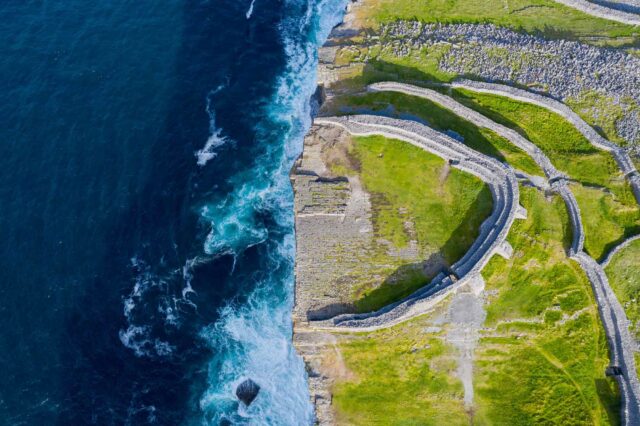The Rich Heritage of Co. Clare
Ennis Friary and Scattery Island are the only two guided OPW sites in county Clare (to date).
Situated in a county with such a rich heritage our guides are regularly questioned about other sites visitors encounter while traveling through the county. Quin Friary and Clare Abbey regularly feature here in Ennis and our guides over the years have compiled a brief handout to inform those wishing to learn more on these nearby sites. A service I believe many of our colleagues
around the country also provide, giving information on sites other than their own.
In conjunction with the Visitor Services 2024 project to promote the unguided sites within the OPW portfolio, the Ennis Friary guide team undertook a project to discover and promote a selection of our Clare unguided sites. Twelve were chosen to display some of the variety of our built and social heritage. Many of the sites have a link to the O’Brien clan, former kings of Thomond and founders of Ennis Friary, and thus a link to our
own site. This research is kept on file in hard copy at reception for our guides and visitors and is available through our social media for all to access.
During the 2024 season, the Ennis Friary Guides embarked on an exciting journey to uncover some of County Clare’s most extraordinary, but often overlooked, historic gems. Starting as a bi-monthly Facebook campaign, our goals included raising public awareness of Clare’s many historic sites, expanding our own online community, and inspiring visits to Ennis Friary itself.
Throughout the season, we researched and visited sites spanning from the Stone Age to the Medieval period, sharing insights on structures such as portal tombs, ring forts, abbeys and castles. One thing we hadn’t anticipated was how deeply the research would impact us. As a team, we’ve shared quiet moments, excitedly recounting the discoveries we’ve made about the places
we’ve chosen to explore. We’ve shared stories that bring Clare’s rich history to life, such as:
– The fierce, bloody battle fought between two opposing O’Brien
factions at Clare Abbey
– The ancient inauguration site of Magh Adhair were the O’Brien Kings of old dramatically chose to perch atop the tomb of a mighty Firbolg warrior
– Kilnaboy Church, a site of sacred pilgrimage once believed to house a relic of the true cross
– And captivating discussions on the breathtaking medieval stone carvings that still stand proudly at some of these historic heritage sites today!
With the Ennis Friary’s Guides’ shared passion, we haven’t only shared Clare’s wonders with others through social media, we’ve also deepened our own appreciation and love for this beautiful
county we call home.
This social media campaign has culminated in the “Unmanned Sites of County Clare” series, now accessible on the Ennis Friary Blog. With Ennis Friary closing for the winter season, we hope
to encourage our followers and history enthusiasts to explore these historic sites in person and through our digital content, enhancing their connection and appreciation to Clare’s historical past.
To find out more about the Unmanned Historic Sites of County Clare please see https://ennisfriary.wordpress.
com/2024/10/08/unmanned-historicsites-
of-co-clare/ for further details.
A day in the life Focal lenár nOifigeach Gaeilge
Dia duit, or should that be Dia dhuit? The former is correct when writing and the latter when speaking. Another one of the many little quirks that adds to the richness of the Irish language
(Saibhreas na Teanga).
Hello, is mise Liam and I am deligh ted to be the new Irish language officer with the Office of Public Works. I joined
the civil service relatively late in life but was very fortunate to land at the ‘Board’. I started as an Executive Officer with National Historic Properties before joining the Conservation Architects as
a Higher Executive Officer. I then saw the advert for Irish language officer, applied, was successful and now I work with the Policy Unit. Each role has suited me greatly because I have a keen
interest in history and culture.
I am also a late-comer to the Irish language. When young, there were no Gaelscoileanna in my locality. There was no Irish at home but my parents were always sympathetic towards the language. I was twice packed off to the Gaeltacht and did not particularly
enjoy the experience, or so I thought. I achieved a Grade C in ordinary Irish at Leaving Cert. I then became an apprentice and drifted from the language but something always kept me interested. I was in my mid-30s when the flame rekindled. I started attending conversation groups, listening to the radio and reading voraciously. I developed a network of like-minded
friends and through that improved my fluency.
My main role is the promotion of An Ghaeilge within the organisation and advising on compliance with the Official
Languages Act 2003 and 2021. There have been recent developments in this area that mean that we in the OPW
have increased legal responsibilities when it comes to Irish and its role in our work. My role is to guide and assist staff to ensure that the Office meets its obligations.
In addition to the legal compliance aspect of my work, it’s also important for me to promote the recreational activities available in Irish. This page Irish Language Tour at Dublin Castle.
Some initiatives that are proving successful are:
– ‘Lón le Gaeilge’– going from strength to strength.
A monthly on-line get-together in a relaxed
environment where people can practice their
cúpla focal in a supportive environment.
– Irish language tours – In addition to OPW sites
in Gaeltacht areas, Irish language tours are now
available at many heritage sites including Rock of
Cashel, Dublin Castle, Casino Marino, Kilmainham
Gaol, Pearse Museum, Royal Hospital Kilmainham,
Custom House Visitor Centre, Kilkenny Castle,
Emo Court and others.
– Staff Irish language courses – The numbers of
staff availing of Onelearning Irish courses is
increasing each year. These are of great benefit to
team members and are completely free of charge.
– OPW representation – We introduced a
popular Seastán Gaeilge (Irish stand) at this
year’s Ploughing Championships, we were
represented at An tOireachtas in Killarney (the
annual language and culture event) and we are
now advising on plans for the development of a
Gaeltacht Quarter in Dublin’s south city centre.
OPW is actively working with many of the Irish
language promotion bodies to help raise the
profile of the Irish language.
The Official Languages Act was introduced in 2003 and it gave
legal status to the Irish language. The primary objective of the
Act was to ensure improved provision of public services through
the Irish language. The Act was strengthened when amended in
2021. As a government agency, the OPW must comply with all
requirements of the Act. Oifig an Choimisinéara Teanga (OCT) is
the Language Commissioner’s Office, an independent statutory
office operating as an ombudsman service and as a compliance
agency. I am the contact person between the OPW and OCT
and I am pleased to say that we have established a good working
relationship with the team at the Commissioner’s office.
If a breach of the Act is reported, OCT will open a case and
contact us. I will liaise with them to remedy the breach and
rectify the problem. In order to do this I require the cooperation
of the OPW staff. I am absolutely delighted with the
co-operation and buy-in that I have witnessed so far. Thank
you all! The main areas of complaint relate to non-compliant
signage, lack of Irish language information leaflets/publications
and Irish language communications answered in English. These
are all easily rectified and once a breach is identified we all
learn from it. The OPW is making great progress in meeting our
requirements under the Act.
In summary, tá a lán déanta ach tá níos mó le deanamh ( a lot is
done but there is more to do). If I can be of assistance to anyone
please do not hesitate to make contact. The easiest way is via
gaeilge@opw.ie Tá mé ag súil go mór le cloisint uait. Ádh mór!
Up in Arms: Heraldry in a Medieval Church
The status of St Audoen’s Church as one of the oldest buildings in continuous use anywhere in Ireland offers an opportunity for the visitor to find relics of our shared past which are well-preserved and still in their original surroundings. This Dublin City parish church’s association with Ireland’s ruling elite of the Norman, Tudor and Stuart eras means that many of those relics bear witness to the principle concerns of that ruling class. In memorialising the dead within St Audoen’s Church they aspired to leave an imposing and lasting reminder of their prestige when alive, and the use of heraldry was central to this.
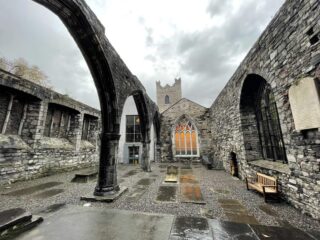
Coats of arms have ancient origins, going back to the need for fighters on the battlefield to identify each other, and the ‘coat’ was initially just a coloured cloak worn over armour. The Normans were the first to develop a formal code of heraldry and by the 12th century, when St Audoen’s Church was built, many Norman lords had their own distinctive coat of arms. Gradually, heraldry became more of a status symbol for the nobility than a martial necessity, and the heraldic devices came to denote social rank and particular family traits or achievements. In the reign of King Henry V (1413-22) the use of heraldic arms without royal permission was outlawed, and in the 16th century the role of ‘Ulster King of Arms’ was established to regulate the design and granting of arms in Ireland, now succeeded within the Republic of Ireland by the office of Chief Herald of Ireland.
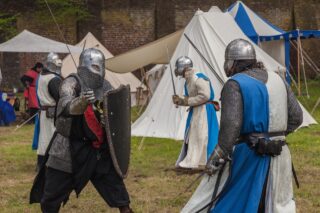
Each component of the coat of arms has a specific name and significance; the terms ‘dexter’ and ‘sinister’ refer to the right and left sides of the arms, but as seen from the point of view of the person holding the shield rather than of the observer. Over time, the central shield of a family’s arms was often divided into halves or quarters to incorporate the arms of a notable maternal family line. The inclusion and the style of a helmet above the shield also had a symbolic interpretation, as did each of the colours used in the design. A motto representing the values or qualities of the family was sometimes added on a banner beneath the shield, usually in Latin, French or Gaelic.
Those arms granted to English and Anglo-Irish lords could officially only be passed on to the eldest male heir. The transfer of these arms was a highly ritualised affair carried out by the Ulster King of Arms during the funeral of the deceased. The National Library of Ireland holds a collection of bound volumes from the ‘Ulster’s Office’ which detail these proceedings all the way back to the 16th century. These volumes were intended simply to keep a heraldic record of who was legally permitted to use arms, but they have become an invaluable source for genealogical research, not least in relation to the many elaborate funerals held at St Audoen’s Church in the 16th and 17th centuries.
While waiting to inherit a coat of arms, the designated heir was allowed to use the arms with the addition of a stripe (or ‘label’) across the top. Younger sons, who were unlikely to inherit, often used a version with additional symbols representing their place in the family pecking order. For example, a crescent represented the second son, a star the third son, a bird the fourth son and a ring the fifth son. A diamond-shaped ‘lozenge’ coat of arms generally represented the unmarried daughter of a family patriarch. The Ussher family – one of medieval Dublin’s leading families – provides a good example of the evolution of variant coats of arms through the generations. Whilst only one living person was allowed to use a coat of arms of English origin, by contrast coats of arms for Gaelic Irish clans were granted collectively, meaning that any family member could use them.

So, what can St Audoen’s Church tell us about the use of heraldry in Ireland during this period?
Although parts of the site have fallen into ruin at various stages of its eight-century history, the highly ornate Stuart-era memorials to the Sparke-Brice and Duffe families are wonderfully preserved in spite of their delicate plaster construction. In monuments overflowing with symbolic emblems it is the coats of arms which are placed at the pinnacle of each, representing the pride these parishioners felt about their lineage. And while any pigments and inscriptions have long-since faded away, these carefully sculpted arms help us to confirm who the memorials were built in memory of.

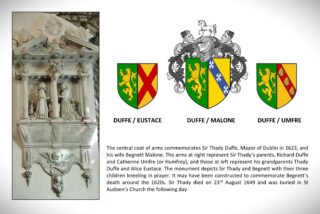
Memorials of a very similar design to the above were erected within St Audoen’s Church in memory of the families of Alderman Edmond Malone and Mayor Nicholas Weston, but exposure to the elements has left almost no surviving trace. An earlier generation of the Malones were memorialised in a smaller, though still highly intricate, wall panel which, due to its construction from stone, has lasted somewhat longer.
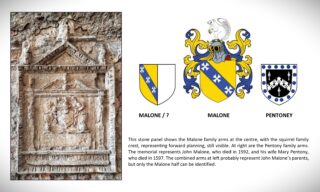
Another stone panel from this era on display inside the visitor centre is linked to Mayor Christopher SeÞgrave, who died in 1589, but it has not fared so well. The oldest identifiable coat of arms in the church is the simple stone tablet in a window recess next the the altar, still used for worship. It depicts the Duffe family arms with the letters ‘T D’.
This is believed to memorialise Thady Duffe, who was Mayor of Dublin in 1548. His name derives from an ancestor, Tadhg Dubh O’Farrell, from present-day County Longford, and in fact the Duffe and O’Farrell arms are identical.
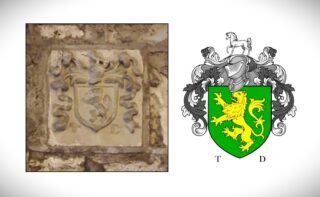
Less grandiose were the ‘ledger’ tombstones which were set into the floor of the church. Fragments of up to 100 of these ledger stones can still be found around the site, but due to the wear and tear of centuries of footsteps only 23 remain even partially legible. Nevertheless, a handful of these retain distinct coats of arms at the centre of their design.
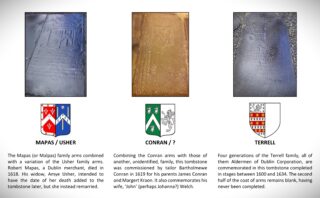
Although styles changed and heraldry in tombstones became less fashionable, some examples of coats of arms survive from the early 18th century. A rare bronze wall plaque commemorates Sir John Peyton and his wife Lady Rebecca Peyton, who died in 1720 and 1730, respectively. Here, the use of Peyton’s arms acknowledges his knighthood in recognition for his services as military Governor of Ross Castle.
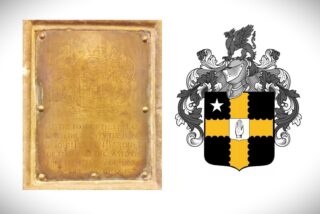
Probably the most famous coat of arms in Dublin to this day is the three castle gates with flaming beacons against a blue shield – the official arms of the city. This has been a symbol of Dublin since the 13th century, but the design was given official status in 1607 by Daniel Molyneux, Ulster King of Arms, who is buried in the vaults of St Audoen’s Church. The arms form the centre-piece of the church’s stained-glass window in reference to the innumerable Mayors and Lord Mayors of Dublin who worshipped in St Audoen’s and found their final resting place in its vaults.
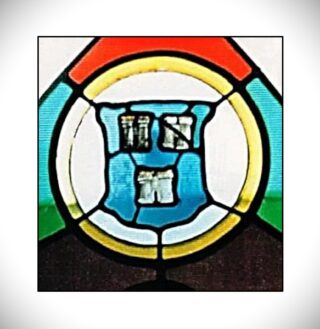
By the middle of the 18th century St Audoen’s Church was no longer associated with Dublin’s high society, and that social tier was itself to become largely irrelevant following the Act of Union. However, the decline in its fortunes most likely saved it from being demolished and rebuilt to modern specifications by some wealthy benefactor, and thus we now find inside its walls a trove of architectural gems stretching all the way back to the late 12th century.
The good news is that it is open to the public, free of charge, each year (currently March to November, 7 days a week). Visitors will find all of the above information and more at the visitor centre reading desk; but for the full immersive experience ask the guides for a guided tour of the site – also free of charge!
Her-story and Her-itage
Women's history, their stories, and their achievements, are often layered within or hidden behind the stories and accolades of men.
We are finally entering a period where women's stories are highlighted and celebrated, and the below names are just a few of the remarkable women associated with our historic heritage sites.
This is Herstory
Margaret O’Sullivan – Garinish Island
*1908 – 1999*
Margaret “Maggie” O’Sullivan lived most of her life on Garinish Island. She began working for the Bryce family in 1926 when she was still a teenager, acting as the housekeeper, attending to high-profile guests to the island, including most of the Irish Presidents who were serving during her lifetime.
Margaret was a fiercely independent woman, rowing her boat back and forth to the mainland to do her shopping and attend mass every Sunday with her dog. Margaret lived on the island until 1998, and was the last permanent resident of Garinish Island.
In 1992 she was recognised by Glengarriff Tourism & Development Association for her contribution to tourism in the area.
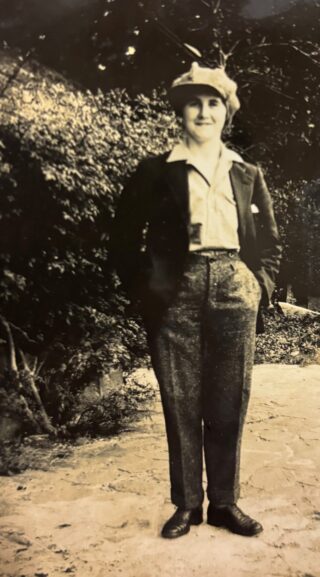
Nancy Wyse Power – Custom House Visitor Centre
*1889 – 1963*
Nancy Wyse Power was a member of Cumann na mBan (1915), the Gaelic League (1901), and a Civil Servant. She received her BA in Celtic Studies from UCD, and continued to do a PhD in Germany on Celtic Philology.
Nancy was heavily involved in the Nationalist cause, helping to deliver messages during the 1916 Easter Rising, and supporting the families affected by the Rising in the subsequent years. She was appointed honorary secretary of Cumann na mBan in 1917.
In 1923 she began working for the Department of Industry and Commerce, and in 1932 was personally requested to be the private secretary of Seán T. O’Kelly, within the Department of Local Government and Public Health at the Custom House.
Nancy was one of the first female Principal Officers in the Free State civil service, and used her position to advocate for equal rights for women in the civil service.
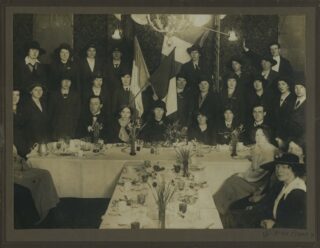
Elizabeth O’Farrell – Kilmainham Gaol Museum
Elizabeth O’Farrell’s story has been hidden from history for years. She was literally erased from key events in 1916, airbrushed from the photos as though she were never there.
It is now known and accepted that Elizabeth and Julia Grenan were in a relationship, living with each other for most of their lives, and doing almost everything together. The two joined multiple organisations including the Gaelic League, the Irish Women’s Franchise League, the Irish Women Workers’ Union, and Inghinidhe na hÉireann. They were taken under the wing of Markievicz and trained in the use of firearms.
In 1916, Elizabeth was assigned to the Irish Citizen Army, delivering messages to Athenry, Spiddal, and Galway City, before returning back to Dublin to medically attend to the injured, and deliver ammunition from the GPO to other garrisons in the city. Both she and Grenan cared for James Connolly after he was shot.
Elizabeth was picked by Patrick Pearse to discuss surrender terms with the British military, and was sent out into heavy fire, armed with only a white flag and a Red Cross symbol. It is she who stands alongside Pearse to deliver the unconditional surrender to General Lowe. Lowe assured Elizabeth that she would not be imprisoned, but after the surrender she was strip-searched and held in both Ship Street Barracks and Kilmainham Gaol. Lowe ordered her immediate release upon hearing of her imprisonment.
During the War of Independence both Elizabeth and Julia delivered dispatches to the IRA, and were strongly anti-treaty, helping to raise funds for the families of anti-treaty prisoners.
In 1967 a plaque was unveiled at Holles Street Hospital, where Elizabeth once worked as a mid-wife, and a foundation to support nurses in their postgrad studies was created. In 2012 City Quay Park, where Elizabeth was born, was renamed Elizabeth O’Farrell Park.
Both Elizabeth O’Farrell and Julia Grenan are buried beside each other in Glasnevin Cemetery.
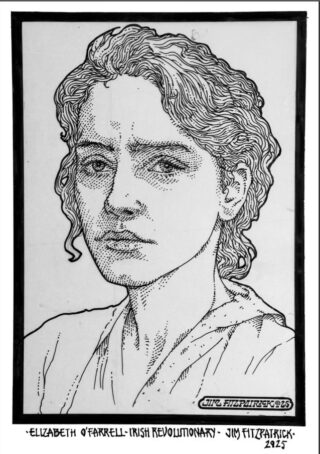
Gwendolen Guinness, The Countess of Iveagh – Farmleigh House & Gardens
*1881 – 1966*
Lady Gwendolen Guinness was one of few women of her time to be elected as a Member of Parliament in the House of Commons. She won her seat in the Southend-On-Sea by-election in 1927, which she kept until 1935.
Though at times Gwendolen was reduced to a fashion icon rather than a parliamentarian, with one report by The Daily Telegraph in 1934 stating that people were ‘eager to see her fashionable clothes’, Gwendolen Guinness remained steadfast in her fight for and defence of women’s rights.
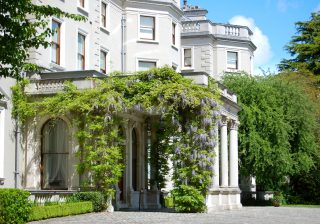
Dr. Kathleen Lynn – Kilmainham Gaol Museum
Dr. Kathleen Lynn was involved in multiple movements throughout her life, including the suffragist, labour, and nationalist movements.
She was a key player during the 1916 Easter Rising, having taught the members of Cumann na mBan first aid, and was Chief Medical Officer of the Irish Citizen Army during the rebellion. She was imprisoned for a time in Kilmainham Gaol for her part in the Rising.
However, her revolutionary involvement is just one side of Kathleen Lynn’s story. She studied in Manchester, Dusseldorf, Dublin, and the US, and was a fellow of the Royal College of Surgeons in 1909. From 1910- 1916 Lynn was the first female resident doctor in the Royal Victoria Eye & Ear Hospital.
She is remembered for her work in St. Ultan’s Hospital for infants and their mothers, and she helped further international research on TB eradication.

Hilda Grove Annesley & Sylvia Cooke Collis – Annes Grove Gardens
*1869 – 1961* – Hilda
Hilda Grove Annesley, nee Macnaghten, married Richard Grove Annesley in 1907 and together they were responsible for creating the paradise garden of Annes Grove near Castletownroche in North Cork. For over fifty years she was the constant presence at Annes Grove welcoming family, friends and visitors from far and near. She was happiest when out riding – she rode side saddle all her life and was admired as a very fine horsewoman.
In 1912, she wrote to Dick (Richard) telling him if she should die suddenly or killed out hunting that he was not to grieve too much as “we must all die someday and I have no wish to live to be older than 50”. She did in fact live until 1961 at the age of 92. Through her diaries and memoirs Hilda left behind an account of country living from the first half of the 20th century.
*1900 – 1973* – Sylvia
Daughter of Hilda Grove Annesley from her first marriage to Henry Cecil Phillips, Sylvia Cooke Collis was born in Glanmire, Co Cork but spent most of her youth in Annes Grove after her mother married Richard. Like her mother she loved the outdoor life and was involved with horses, dogs and fishing (her step father was a very keen fisherman). She also developed an interest in art and studied under John Power at the Crawford Municipal School of Art and later trained with Mainie Jellett, with whom she became friends.
She was good friends with another famous neighbour in North Cork, Elizabeth Bowen, who encouraged Sylvia further in her endeavours. Sylvia exhibited widely in the mid-twentieth century and was known as a modern artist, influenced by Jellett herself and the Fauve movement. No longer a household name, her art nevertheless has stood the test of time and may be due a revival.
- courtesy of Aileen Spitere

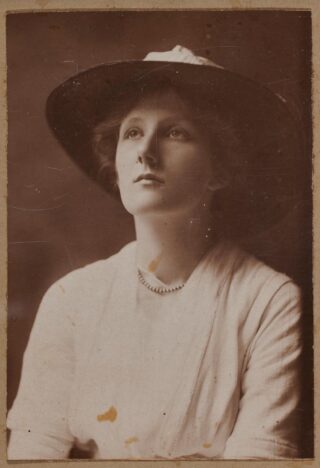
Countess Constance Markievicz – Kilmainham Gaol Museum
*1868 – 1927*
Constance Markievicz was heavily involved in the revolutionary fight for Irish freedom and in Irish politics. Her involvement in the republican movement dates to 1908, when she joined both Sinn Féin and Inghinidhe na hÉireann – both of which she became an executive member of in 1911.
Markievicz was sympathetic to the workers cause during the Lock-out in 1913, and set-up soup kitchens. She was the honorary treasurer of the Irish Citizen Army, and was responsible for the merging of Inghinidhe na hÉireann with Cumann na mBan.
During the 1916 Easter Rising, Markievicz was second-in-command to Michael Mallin at Stephen’s Green/Royal College of Surgeons, a role for which she was imprisoned for 14 months. She was held in Kilmainham Gaol for a short period, before being transferred to Aylesbury Prison.
Markievicz was the very first woman elected to Westminster in 1918, but as a member of Sinn Féin, and someone who did not recognise the British Parliament, she refused to take her seat. In March 1919 she became minister for labour in the first Dáil Éireann.
Constance Markievicz is now buried in Glasnevin Cemetery.
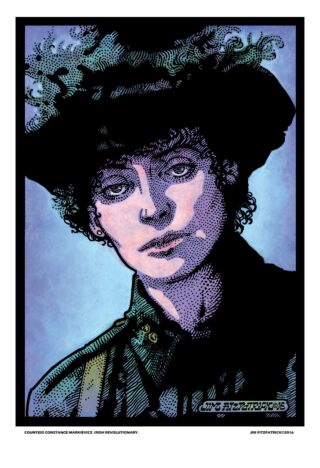
Margaret Pearse – Pearse Museum, St Enda’s Park
*1857 – 1932*
Margaret Pearse was a staunch nationalist and elected member of Dáil Éireann in 1921; vocally Anti-Treaty, Margaret was dedicated to keeping the memory of her two sons (Willie and Patrick Pearse) alive in everything that she did after the executions in 1916.
Margaret raised funds to keep the school Patrick set-up, St. Enda’s, running for as long as possible, travelling to America in 1924, raising $10,000 while there.
Margaret Pearse was given a state funeral upon her death, and is now buried in Glasnevin Cemetery.

Lady Anne Wandesforde, The Countess of Ormond – Kilkenny Castle
*1754 – 1830*
Lady Anne, born Susan Frances Elizabeth (Anne) Wandesford, was heiress to the family mines in Castlecomer.
She married into the Butler family, and focused on healthcare within the Castlecomer area, organising the set-up of a fever hospital and infirmary during the 19th century.
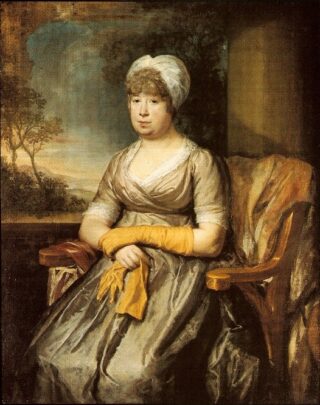
Lady Louisa Conolly – Castletown House & Parklands
*1743 – 1821*
Lady Louisa dedicated the later years of her life, after her husband’s death in 1803, to charitable works.
She established a female charter school, as well as industrial schools were children could be trained in various trades. She also had a church built, and believed that both Catholics and Protestants should be educated together.

Angelica Kauffman – Rathfarnham Castle & Dublin Castle
*1741 – 1807*
Renowned neoclassical-style painter Angelica Kauffman is famous for her portraits and history paintings, capturing some of the most influential people of her time through her art.
A founding member of the Royal Academy in London, Kauffman’s talents were highly sought after by the elite, including the Earl of Ely of Rathfarnham Castle. She visited Ireland briefly in 1771, and some of her portraits of the Loftus family still reside in the Castle, including one of the Earl himself, Henry Loftus (see below).
Some of her historical paintings can also be viewed within the State Apartments of Dublin Castle.

Grace O’Malley, The Pirate Queen – Clare Island & Kildavnet Castle
*1530 – 1603*
The legendary Pirate Queen, Grace O’Malley, was a formidable woman, asserting her leadership in a man’s world.
From a young age Grace showed determination, cutting her hair short to look like a boy so that she could board her father’s ship, when he refused her access. This action earned her the nickname of ‘Gráinne Mhaol – Grace the Bald’.
Her first husband, Domhnall O’Flaherty, engaged in ongoing fighting against the Joyce’s for control of Hen’s Castle in Co. Galway. After he was ambushed and killed by his enemies in 1565, Grace defended the castle, refusing to surrender to her enemies, and forcing them to retreat.
Grace became known as one of the most feared sea captains in Ireland, commanding a fleet of ships and an army of 200 men.
Sir Nicholas Malby, Governor of Connaught, said of her at the time that she ‘thinketh herself to be no small lady’ – she was not one to hide her light under a bushel.
Sir Henry Sidney proclaimed Grace ‘a notorious woman in all the coasts of Ireland’.
Today, many OPW sites are associated with Grace O’Malley, including Kildavnet Castle which bears her name ‘Granuaile’s Tower’, and Clare Island where she is said to be buried.
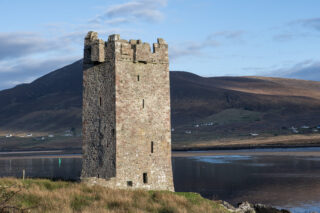
Portrait Miniatures and the Irish Country House
A catalogue of the collection of portrait miniatures donated by Edmund Corrigan to the Irish Georgian Society (IGS) for display at Castletown and Doneraile Court has been published by the IGS in October, 2024. It provides comprehensive catalogue descriptions on the sitters in the portraits and the houses they resided at. Author Kevin Mulligan has unearthed vast quantities of information that connects miniature to miniature, family to family, house to house adding significantly to our understanding of the interlocking family and social histories of Irish country
houses. Paul Caffrey, leading expert on miniatures notes ‘few historic family collections of miniatures survived in Ireland making this a truly remarkable collection of national importance’.
In addition to the detailed catalogue entries and images of sitters there are carefully sourced illustrations of the houses the sitters lived in. The watercolours, pen and ink drawings and paintings of the houses, topographical views and landscapes work especially
well. Kevin weaves a magically interwoven account throughout the 221 catalogue entries.
William Laffan contributes a fascinating essay on the history of portrait miniatures which sets the context to the significance of Edmund’s collection and the links to literature are particularly
effective.
The background to the making and researching of the catalogue goes back to 2016 when miniatures of the Boyle and Fitzgerald families were presented on loan to Castletown and went on
display in the Print Room. The following summer Donough Cahill, Director of the Irish Georgian Society (IGS) raised the possibility of a substantial miniature collection being made available for Castletown on long-term permanent loan. The Collection was to be donated to the IGS by Edmund Corrigan. Following agreement with the Director of National Historic Properties, Rosemary Collier, Dorothea Depner and I progressed plans for the Edmund Corrigan Collection of portrait miniatures, in association with the
Castletown Foundation, to be housed at Castletown. By the middle of 2018 the IGS was getting ready to transfer the miniatures and it was agreed that a small selection of the miniatures would be housed at Doneraile Court – Edmund had fundraised for the earlier conservation works at Doneraile Court
in the 1980’s and wanted to support OPW’s work now in presenting suitable and interesting collections at Doneraile. Ludovica Neglie made the first inventory of the collection investigating provenance with Edmund.
The Chairman of the Castletown Foundation (CF) David Sheehan together with the late Jeanne Meldon, Director and former Deputy Chair of the CF commenced work on how best to display
the miniature collection. Pat Murray, another Director of the CF, had been supporting Edmund in his collecting and together plans started to come together. David knew that Edmund was clear the
style of presentation was to be Country House and David Sheehan designed a scheme for the Lady Kildare Room. Conservation of the Lady Kildare Room and bringing it into visitor tours had been
under discussion for some time. The arrival of Edmund’s collection and the challenge of how best to display it was the catalyst to the conservation project. Jeanne had a wonderful knowledge of the families and the houses and gave much time and effort into organising the groups by family and houses. David
Hartley at Castletown took control of the care of the miniatures working to David’s layouts for the room and Sandra Murphy took charge of ensuring the guiding team prepared for interpreting
the collection to visitors. Joanne Bannon, Historic Collections Registrar, led on the loan agreement documentation between OPW and the IGS in line with the Museum Standards Programme of Ireland (MSPI). The cases for display of the miniatures were at the house including the Luggala bookcase from the Green Drawing Room, upcycled unused frames and furniture from the Farmyard. It all combined to make a most suitable receptacle for the collection. A beautiful porcelain desk set donated by the late
Della Howard through the London Chapter of the IGS is part of the displays in the Lady Kildare Room and it was the late John Redmill and John Berger who presented that to Castletown. In parallel work was beginning to take off on the upgrade and conservation of the Ground Floor at Doneraile Court.
It was so special that Edmund could be present when Doneraile Court – a house he had fundraised for and donated several paintings to – re-opened in June 2019. He could see the interiors come back to life with two stunning framed displays of his portrait miniatures. It was another day of great celebration when in the final few days – unknowns to us - pre Covid lockdown – we gathered on 6 March, 2020 to view the collection installed in the Lady Kildare’s Room together with the celebration to mark the
acquisition of the Duchess of Leinster portrait by Reynolds – a joint purchase by the OPW/CF and the Friends of the National Collections of Ireland (FNCI). It was a delight to see Edmund enjoy seeing the miniatures presented so magnificently. When the second phase of Doneraile Court was completed we were delighted that Edmund was able to view the displays in May 2023, just months before his untimely death. The two interiors of Castletown and Doneraile fittingly bookend the Foreword to
the newly published catalogue on the Edmund Corrigan Collection. A job well done and a fitting testimony to excellent outcomes for Ireland’s cultural heritage from the careful nurturing of private philanthropy with charitable and public institutions. The Edmund Corrigan Collection at Castletown and
Doneraile Court is something we can all be proud of.
From the Blasket Islands to Springfield Massachusetts A Well Worn Path
For the past twenty five years, a group of Dingle Peninsula businesses make their way to Springfield Massachusetts for the
Big E – the Eastern States Exposition – a three week event that draws 1.7 million visitors. It is a well worn path in both directions and very much a meeting of friends.
Springfield has an amazing connection with West Kerry and the Blaskets, very much evidenced by the gathering of the city’s great and good, including many Blasket descendants, at a recent exhibition opening in Springfield Museums which celebrated the
heritage and impact of the Blasket islanders in that part of the world. The temporary exhibit was the first fruit of a Memorandum of Understanding signed last May between the OPW and the Museum. The guest of honour was the remarkable Mairéad Kearney-Shea, at 102 years young, longtime Springfield
resident and the only surviving woman born on the Great Blasket.
That the OPW and the Blasket Centre in particular would be represented at such an occasion and at the Big E is a natural expression of the deep and very much current ties of history, kinship and friendship that are so important to nurture today. My visit, which followed a similar trip by then Minister Patrick O’Donovan in September 2023, allowed me to reach out and thank places such as the John Boyle O’Reilly Club, the Sons of
Erin and the Irish Cultural Centre of New England who regularly organise tours to Ireland and see the Blasket Centre as a
highpoint of their trip.
My Springfield trip coincided with that of a Kerry County Council delegation led by Cathaoirleach Breandán Fitzgerald and Irish Consul General, Sighle Fitzgerald. This significant combined representation was noted and greatly appreciated by
our Western Massachusetts friends, at all levels.
Springfield is an intrinsic part of the Blasket story. Waves of Blasket emigrants sought a place where they could deal with the enormous dislocation of leaving their native home in a place where they could at least share their language and culture and have a supportive community network. That difficult transition and their subsequent success in their new country is the foundation of a shared and invaluable heritage that is enormously
important – on both sides – now and into the future.
The Oldest Grave at the Rock of Cashel
Despite the Rock of Cashel being a singularly unique collection of medieval buildings perched dramatically on a natural limestone outcrop, questions from visitors often concern not the buildings, but the graveyard. While people are always intrigued to hear
that the Rock of Cashel is still an active burial ground, one of the most common questions we receive is ‘which is the oldest grave?’ The answer to this question is not as simple as it might seem. While graves from the eighteenth and nineteenth century
can be seen dotted throughout the graveyard, older graves can be found inside Cormac’s Chapel and St. Patrick’s Cathedral, although most are not in their original location.
Within Cormac’s Chapel sits a large sarcophagus of early-twelfth century date. Thought to be the tomb of Tadhg Mac Carthaig, the brother of the chapel’s builder, Cormac Mac Carthaig, it now
sits against the west wall of the chapel.
Its original location is unknown, but it was likely placed in a recess in an earlier church on the site that no longer stands.
Elaborately carved with intertwining animals in the Urnes style, it likely dates to the mid-1120s, shortly before the construction of the chapel between 1127 and 1134. However, excavations carried out in and around Cormac’s Chapel in 1992 and 1993 revealed graves possibly as old as the sixth century which could have formed part of an early royal graveyard at the site connected to the traditional kings of Cashel, the Eóganachta. These, then, would be the oldest graves on the site. However, none of these are marked above ground level.
Several medieval grave-slabs can also be found inside St. Patrick’s Cathedral. In the early-nineteenth century Archdeacon Henry Cotton made an effort to collect the better examples of carved stone at the Rock and gather them together within the confines
of the cathedral. Many of these are illegible but the earliest identifiable slab dates to 1503 and belongs to a Julius O’Kearny, an attendant of St. Patrick’s Cathedral. This, then, would be the
earliest identifiable grave with a date attached to it. A second slab, located in a side chapel in the north transept, dates to 1506 and belongs to Patrick Connolly, Burgess of Cashel, and Joanna
Wale, his wife. Several others date to the early-sixteenth century including the grave-slab of the Archdeacon of Cashel, Robertus Hackett, who died on 10th December, 1510. However, one small fragment of a grave-slab in this area may date to the late-thirteenth or early fourteenth century. All that remains is the bottom of the slab which shows a pair of pointed shoes, and the bottom of a cloak that reaches the figures ankles. While no inscription survives, the style makes it clear that it is from this time period. Another slab, again from the late-thirteenth or
early-fourteenth century, is hidden away inside a mural passage in the nave of the cathedral, where it has been reused as a
lintel stone. Considering this portion of St. Patrick’s Cathedral dates to the late thirteenth century, the slab likely dates to this period or earlier as there is no evidence that the slab was inserted later.
In the two side-chapels of the north transept, are the remains of sixteenth century altar-tombs, again collected together by Archdeacon Cotton. In the north side-chapel, the remains of an altar-tomb depicting various saints can be seen, produced by the famed O’Tunney school of sculpture. In the south side-chapel of the north transept are the very well-preserved remains of a second altar-tomb, again depicting saints, this time produced by the Thurles school of sculpture. While much of these tombs have now been lost, they likely had a full effigy on top. These may not
be the earliest tomb sculptures to have survived on site, but they are certainly some of the finest.
With graves dating back possibly as far as the sixth century, and the earliest identifiable grave-slab dating to 1503, the graveyard continues to intrigue visitors. The questions we receive show a desire from visitors for a human connection to the site, one that goes beyond history and architecture, and one that connects people to those for whom the Rock of Cashel was part of
everyday life.
Monasteries of the Moy
Growing up in the hinterland of the ancient edifices of Rosserk and Moyne Abbey in Co. Mayo, left a distinct impression on me, and an acute awareness since childhood of ancient Ireland. These ancient ruins sit in a landscape peppered with historic landmarks such as standing stones, the ruin of a 13th century castle across the river and a nearby Holy Well, Tobar Mhuire, housed in a small stone building erected in 1799. This is the landscape that shaped me, inspired my love of architecture and my appreciation of the craftsmanship of the past.
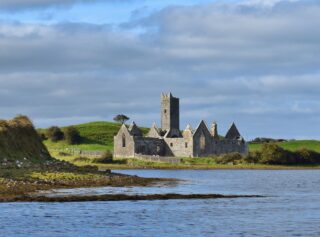
Rosserk Abbey was founded in the fifteenth century by the chieftain of the Joyces, a powerful family of Welsh origin, who settled in Connacht in the thirteenth century. The friary of Rosserk housed a community of friars of the Third Order of St. Francis or the Tertiaries. Unusually this order consisted of married men and women who wished to lead a Franciscan life, but because of their marital status, were not able to join the First Order (friars) or the Second Order (nuns). Prior to the construction of the abbey, the area was called ‘Ros Serce’, named after a miracle working female saint called Searc, a disciple and alleged sister of St. Patrick who resided there. It is speculated that the foundation of the abbey at the Rosserk site occurred somewhere between 1400 and 1441 as the Tertiaries enjoyed wealthy patronage in medieval Ireland. The buildings are grouped around an open cloister, three sides consist of vaulted chambers with a church on the remaining side topped by a bell tower. The kitchen, dining hall and dormitories were located at the first floor level. The abbey has an intact double piscina topped by angels carved in stone, this is a recess with a stone basin for washing sacred vessels used during religious ceremonies. In the late sixteenth century, the abbeys of Rosserk, Moyne and Rathfran, were sacked and burnt by Sir Richard Bingham, English Governor of Connacht. By the 1800’s Rosserk had been abandoned for over two hundred years and walls in many places were on the verge of collapse. In the 1880’s the abbey was taken in to the care of the Commissioners of Public Works who ensured that walls were secured, stonework pointed, and window tracery restored, the original pieces found in the surrounding debris. Works to this National Monument was carried out in Rosserk in 1883, under the direction of the architect, Mr. Thomas Newenham Deane R.H.A.

Further down the river towards the ancient village of Killala, sits the larger and imposing ruin of Moyne Abbey. Set further back from the River Moy, Moyne rests in luxuriant green fields, its high tower can be seen for miles around. The Franciscan Friary of Moyne was founded by Mac William de Burgo in 1455, and the building was consecrated in 1462 by the Bishop of Killala. Moyne once possessed a valuable library being a provincial school of the Franciscan order, together with an infirmary and a mill for grinding corn. A well preserved enclosed cloister exists at the heart of the building, an enclosed walkway where the friars prayed and meditated. The more rudimentary elements of monastic life were also accommodated within the abbey walls, including a kitchen and dining hall, sacristy, chapter house and the dormitories. The monastery was burnt in 1590 by Sir Richard Bingham, the English Governor of Connaught. The friars left after suffering persecution at the hands of Bingham, and the lands of the abbey came into the possession of Edmund Barrett. Later it was owned by an English widow, she allowed the friars to return to the Abbey in 1606, where they remained until 1618. Moyne was later owned by the Lindsay family who demolished part of the monastery with gun powder. In 1718, the abbey came into the possession of the Knox family, Francis Knox, the son of William Knox of Castle Rea, took up residence at Moyne after his marriage to Dorothea Annesley. It is said that during the sacking of the abbey, a soldier by the name of Knox killed the last abbot of Moyne. Parts of the abbey were still habitable and Francis re-modelled a wing of the monastery and lived there. After the Knox family left Moyne, the property was bought by the Kirkwood family who are associated with nearby Bartra Island. In the early 1900’s the predecessors of the OPW carried out works to stabilise the structure, access at this time could only be granted by requesting a key from the caretaker’s cottage. Over the last century, since both monasteries passed into the care of the OPW, their constant care and attention over the decades has ensured that these ancient structures have endured and continue to fascinate all those who visit them.
The Education Programme at Dublin Castle
Since launching our Education Programme in May 2023, we’ve sought to enable access to the art collection and history of Dublin Castle. It’s all been a learning process, and one that we’re excited to be involved in.
Prior to the design and build of the Education Room in September 2023, our social media platforms needed to disseminate information in a way that was accessible and engaging. We chose specific paintings, textiles and sculptures to discuss art terminology like chiaroscuro, stuccowork, memento mori and contrapposto in a way that was user-friendly. We grouped specific artworks together under themes like Birds in the Collection, Art Inspired Recipes and L’Influence Française to capture varying audience demographics. We created a Quiz Time highlight on our Instagram page encouraging users to test their understanding of Dublin Castle’s art collection and history. In January 2024, we announced Astrology as the theme of the Education Programme and this has anchored our decisions regarding family-friendly workshops and social media posts throughout the year. The theme has been an enjoyable way to explore the history of the site, encouraging new links to be made between artworks.
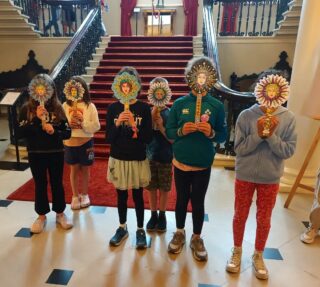
Since May 2023, the Education Team has designed and delivered over 100 individual events as part of our Education Programme. In this year alone, we delivered over 70 free educational events on site, including talks, tours, workshops and demonstrations. In August, we hosted 13 educational events, 11 of which took place during National Heritage Week 2024. It was a wonderfully diverse programme made possible by the talents of the Guiding Team and external collaborators. From Apollo Marks inspired by the stuccowork ceiling of the Apollo Room to Origami Skull Bookmarks inspired by painterly depictions of St. Jerome, we had lots of fun and engaging activities to offer members of the public. We ended theweek on a high, celebrating Wild Child Day with the delivery of a Bird-Box Workshop inspired by those hanging in the trees of the Dubh Linn Gardens. Following the success of the Focal an Lae social media posts and our Turais Trí Ghaeilge, we launched our very first Caint agus Comhrá session in October
2024. This drop-in session will be a monthly event in the Education Room of Dublin Castle. The purpose is to provide a space and framework to speak Irish in a comfortable, relaxed and historically rich setting. It’s another mode of engagement and one that we’re excited to offer as part of our Education Programme. Based on the popularity of our Respond to the Artwork workshops, we’re continuing to adopt ‘slow-looking’ strategies in leading our family-friendly and dementia-inclusive sessions at Dublin Castle. These workshops offer participants space, time and guidance in discussing the art elements as
they relate to chosen artworks in the collection, before completing an appropriate art activity. It’s a format that captures active learning across all age groups, and one that we’re keen to develop in upcoming years. Currently in development is our Educational Video Series, which will provide insights into selected artworks in the collection. These short videos will assist teachers, students and members of the public in learning about the collection in a way that is art-specific and student friendly. We’d like these videos to be part of an ongoing project that complements the Art History curriculum at post-primary level. We recently launched our Painting Pursuit Educational Resource, a trail
that celebrates the artwork of the State Apartments and challenges detectives of all ages to decipher clues hidden in the paintings. It’s been a fun project to lead, and will complement both the ‘Death in the Collection’ tour and ‘Secret Agent’ tour at Dublin Castle. Moving forward, we’re excited about the inclusion of a Portfolio Preparation Course and regular drawing sessions within our Education Programme.

This interest stems from personal experience studying and teaching observational drawing in the classroom setting. Given how fortunate we are to have life-sized plaster cast statues in the collection, there is lots of scope for developing Bargue and Cast Drawing classes in upcoming years. On a final note, I’d like to extend my thanks to the staff at Dublin Castle for their ongoing support towards the work of the Education Team. Since establishing our Programme in 2023, progress has been accelerated through the build of the Education Room, the expertise of the Guiding Team and the contributions of external historians and artists. It’s all been in the pursuit of an engaging programme of events, and we look forward to developing more learning opportunities for people in the future.
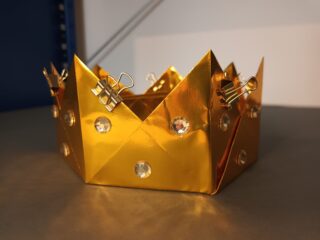
Medb of Connaught
Queen. Warrior. Goddess. Medb of Connaught was many things within Celtic mythology.
As Queen, Medb ruled over the province of Connaught, overseeing her kingdom
from her seat of power at Rathcroghan.
As Warrior, Medb raised an army against Ulster to ensure she would gain possession of the Brown Bull of Cooley.
As Goddess, Medb represented fertility and sovereignty, offering men the power of kings through marriage.
With the mounds of Rathcroghan, and the cairn at Knocknarea said to symbolise parts of Medb’s body, it signifies the legacy that she left within Irish pseudohistory - her powerful connection to the land that is written in the earth itself.
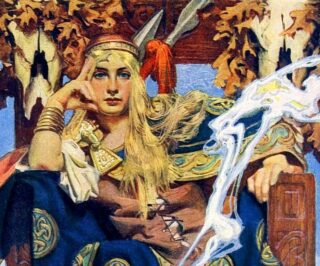
According to mythology, the epic battle known as the Táin Bó Cúailnge (Battle of Cooley) was incited during a seemingly innocuous conversation between Medb and her then husband/consort, Ailill Mac Máta. What started as a bed-time discussion turned into one of the most brutal fights in pseudohistory.
“In Ailill’s herd there was a magnificent bull called the White-horned and Medb had none to touch it.”
As comparisons are made between the couple over who has the greater fortune, the most prized possessions, they realise they are equal in all things…bar one. Where Ailill is in possession of Finnbennach, the great White-Horned bull (who was once owned by Medb), Medb has nothing to match.
Knowing that the only way to surpass Ailill’s fortune is to obtain the Brown Bull of Cúailnge, Medb rallies troops of men behind her from her seat at Rathcroghan, and goes to war against Ulster when the bull’s owner refuses to hand him over.
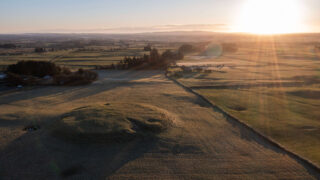
There are two ways of reading Medb’s actions here:
The first is to see her decision to go to war as juvenile and trivial, risking people’s lives for mere belongings, just to win a competition against her husband.
The second, however, provides us with a more nuanced depiction of Medb’s character, as Queen, but also as a woman. According to Sylvia Brinton Perera, Medb’s decision to go to war signifies a determination to maintain independence, to retain and protect her power over herself and her land, from what Perera calls “the rising patriarchal Celtic aristocracy.”
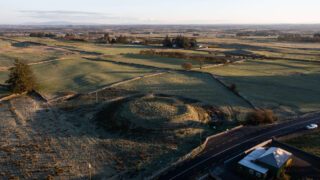
Ailill receives his power, his authority, via his marriage to Medb; without her, his rule is not legitimate, demonstrating the influence that Medb holds. As the recognised Sovereign of Connaught, her authority over the lands of Rathcroghan and its people is power that Medb does not want to lose. Her being is so tied to Rathcroghan that her bodily functions actually alter the landscape when her menstrual blood creates the earthwork channels known as the Mucklaghs.
The Táin Bó Cúailnge symbolises Medb’s fight to remain equal to her husband and retain the lands that are so much a part of herself.
“ I have never heard in all Ireland of a province run by a woman except this one.”
Ailill confirms the power that Medb has within Connaught with this statement, which is why only Medb can determine who becomes king through a sacred marriage ritual.
This ritual involved the chosen man becoming so drunk that it would grant him access to the spiritual world, thus receiving the knowledge required to rule a kingdom. The word mead has a close correlation with Medb’s name, meaning ‘drunken one’ or ‘she who makes drunk’.
Perera notes that in other folklore, as well as Celtic, the goddess of sovereignty is not only the one serving the drink, but is also the drink herself, therefore giving her future king the power and knowledge to rule alongside her divine self. Only those kings selected by Medb were recognised by the people.
However, if the king was no longer fulfilling his duty, both as ruler and husband to Medb, the failure would be reflected in the land. Land that Medb is visible in.
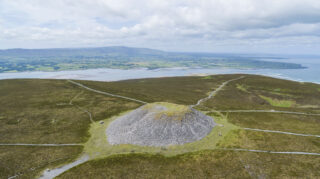
At Rathcroghan, its earthworks and mounds reflect Medb’s bodily fluids and her physical form.
At Tara, where Medb’s father was King, the henge Rath Maeve is named after her (which could also refer to her predecessor Medb Lethderg).
At Knocknarea, Queen Medb’s Cairn is a symbol of the life/death cycle, representative of pregnancy in its rounded shape among the mountains, while also being Medb’s supposed resting place.
According to Gerard Mulligan, parts of Rathcroghan may have been deliberately created to represent Medb, “allowing the king to be ‘physically’ close to the goddess” even when she is not there, always maintaining that connection to his source of power.
The reach of Medb’s power across Ireland cannot be underestimated. Whether as Queen, Warrior, or Goddess, Medb holds sway over kings, wars, and the landscape. Despite warring opinions of her character, Medb is one of the best known ‘players’ in Celtic Myth, to the point that many Irish monuments are associated with her name.
It makes it hard to deny that Medb of Connaught is anything but legendary.
Sources:
Brinton Perera, Sylvia. Celtic Queen Maeve and Addiction: an archetypal perspective, 2001.
Dictionary of Irish Biography. Medb Chruachna, contributed by John Carey.
Lehmann, Edyta, 2008. ‘And thus I will it’: Queen Medh and the Will to Power. Jstor.
Mackillop, James. A Dictionary of Celtic Mythology, 2004.
Mulligan, Gerard, 2011. Archaeology and Myth: a consideration of the ancient royal site of Rathcroghan. Jstor.
Neolithic Cúil Irra, Co. Sligo – Knocknarea / Carrowmore / Carns Hill. 2017. Jstor.
Ó Cathsaigh, Tomás, 2002. “Táin Bó Cúailnge” in Coire Sois, The Cauldron of Knowledge. Ed. Matthieu Boyd. Jstor.
Waddell, John, 1983. Rathcroghan: a royal site in Connacht. Jstor.
Waddell, John, 2009. Rathcroghan, Co. Roscommon: where the Táin Bó Cúailnge began. Jstor.
